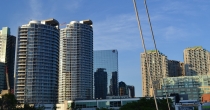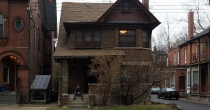The World Within a Block: The Past and Future of St. James Town, Toronto
By: Lucy Zemljic on April 7, 2014 St. James Town has been called many things over the years. The Toronto neighbourhood has been deemed Canada’s most densely populated community, and because of the wide range of immigrant populations, is sometimes even known as “the world within a block”.
St. James Town has been called many things over the years. The Toronto neighbourhood has been deemed Canada’s most densely populated community, and because of the wide range of immigrant populations, is sometimes even known as “the world within a block”.
Nestled between Parliament, Sherbourne, Wellesley and Bloor, in the northeast corner of Ontario’s capital, this neighborhood has history that goes all the way back to the 1870's. But despite its rich history, cultural diversity, and downtown location, St. James Town has had a difficult past, and is facing an uncertain future.
The Early Days
In the 1870’s, St. James Town was flourishing. Charming Victorian houses lined the streets, and their occupants were distinctly upper middle class. It became a semi-suburban haven for well-to-do families, and was a highly desirable place to live. This trend continued into the 20th century, until major zoning changes in Toronto’s downtown core changed the face of the area.
“Towers in the Park”
In the 1950’s, those picturesque Victorian homes were leveled as part of new zoning, and private developers clamored to take advantage of the situation. By the end of the decade, the old houses were gone, replaced by the city’s first high-rise apartments. The apartment towers were inspired by French architect Le Corbusier’s modern concept of Towers in the Park. This was an urban design plan popular in the 50’s and 60’s in which existing urban fabric was leveled and replaced by new high-rises, which were surrounded by open space.
The Birth of a Community
This is how St. James Town as we know it was born. Every apartment tower was named after a major Canadian city, and became home to thousands of residents. Each high-rise was surrounded by open green space, but lacked severely in amenities. And although it was originally designed to appeal to young, middle class residents – specifically singles and professionals – much of the intended demographic saw the area as less than appealing. The “swinging single” middle class moved instead to suburban areas such as Scarborough, Etobicoke and North York. The dream of St. James Town quickly lost its lustre, and the area became much poorer.
Modern-Day St. James Town
Since then, St. James Town has consistently been home to low and moderate income families, with the province building four public housing units in the area. According to the 2006 Canadian census, the average income of St. James Town residents was one of the lowest in Toronto, at $22,341. St. James Town is now largely a community of new immigrants, and the buildings experience a high turnover rate, as residents generally “move up” after a few years in the area. Although this high turnover rate is most often seen as having a negative effect on communities, St. James Town residents have banded together to offer culturally diverse resources and services to the flow of new immigrant families. Cultural organizations and home-based daycares are prevalent in the area, which comes as no surprise given the extreme density of the population living there.
Issues Facing the Community
There are several difficulties that residents of the St. James Town community face on a daily basis, and many of these stem from a few key issues surrounding the area.
Extreme Population Density
St. James Town is a community of 19 high-rise apartment buildings, and 4 low rise buildings, that contain more than seven thousand units, in an area of 32 acres. These buildings are home to about 17,000 residents, and this is only the official number – many residents believe that the actual number is much higher, at 25,000. With that many residents living within only a few city blocks, St. James Town is unquestionably the most densely populated community in the country, and one of the most densely populated in all of North America.
The extreme population density of the St. James Town community has caused widespread overcrowding in the area, and there are simply not enough resources to serve the large and culturally diverse community.
Lack of Public Spaces
Because of the way that it was designed and built, St. James Town is a “concrete neighborhood”. High-rise buildings are surrounded by concrete and open space, and there is simply a lack of green space in the community. Without parks and general areas for the residents to engage in leisure activities, feelings of isolation and alienation are common in the area. The lack of green spaces and leisure areas stems from the intent of the community’s original design. St. James Town was meant to be a “yuppie utopia”, geared especially towards single people, and the neighborhood was not originally designed to house children. When the high-rise buildings were first constructed, it was even against the law to house children in the area. This seems to explain why resources such as parks, playgrounds, and local day-care centres are absent.
Parks and green spaces, where neighbourhood residents can meet and engage in leisure and physical activities, are a vital part of any community. It is an important part of the physical and mental health of its residents, and helps them feel more a part of their community. A lack of such spaces inevitably leads to negative influence on the health of residents, both physically and mentally.
Poor Building and Neighbourhood Maintenance
Another key issue facing the community is the poor maintenance of the buildings themselves. The existing apartment buildings are severely crowded, and many are in constant need of new repairs. The four city-owned apartment buildings, that offer rent based on income, are especially susceptible to the effects of poor maintenance. According to participants of an urban health focus group in the area, many of the buildings geared towards income are “rundown” and “unsafe”, and simply overcrowded and unable to cope with the density of the population. According to these participants, St. James Town residence deal with abnormally long wait times for elevators, faulty electric systems, plumbing that frequently breaks down, and garbage disposals that routinely overflow.
An Uncertain Future
The future of St. James Town may see even more residents coming to Canada’s densest community, thanks to a mega-developmental proposal for a section of North St James Town. The population of this already overcrowded neighbourhood could increase even more if the new condos planned for the area are built.
The plan includes four skyscraper towers that range from 46 to 56 storeys in height, along with some low-rise buildings, that would add more than 1800 condo units to the area. In the process, Four heritage buildings would be demolished.
It’s become clear, however, that some residents are concerned of these plans, and worry that new condos bringing in more people will profoundly strain the already-limited resources and services. The concern is that bringing in new condos will not fix existing problems, and the spaces should instead be used to build new resources for residents, such as basketball courts, swimming pools, and parks. Adding a slew of new condos to an already overcrowded area may simply bring more people into an area without first addressing the underlying problems.
Yet there are others that insist that these condo developments will inject new life into the area. Some believe that these new condos will increase income levels in the community, as developers attempt to bring in young professionals to fill the new condos. This influx of young residents will, according to some, bring new shops, bars, and cafes to the area.
It remains to be seen whether these developments will cause more strain on the community, or will instead rejuvenate the neighbourhood.


